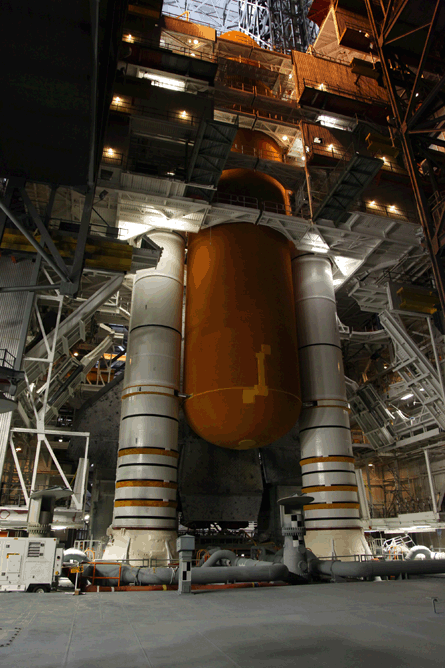NASA programme managers have finally found the cause of the cracks on Space Shuttle Discovery's external fuel tank - and a fix - setting a possible launch date of 24 February, the US space agency says.
Teams of engineers have been searching for more cracks, and their cause, since November.
"This was a tough problem," says John Shannon, the Shuttle programme manager. "I'm very confident that we've finally gotten it figured out and we have a fix that is easy to implement."
As originally thought, the stress of loading extremely cold liquid oxygen and hydrogen into the tank played a partial role in the cracks, Shannon says. Further investigation has shown that another contributing factor was that this set of stringers is not as fracture-resistant as earlier batches had been.
 |
|---|
© NASA |
Tests on Discovery's tank have not been able to pinpoint either material quality or flaws from assembly as the sole source of the cracking problem, showing it is likely to be a combination of both, NASA says, calling the matter "hard to quantify."
"It's been a long road," Shannon says. "I'm very confident we have it finally figured out and we have a fix. We're going to fly with a lot of confidence in this tank."
According Shannon, the same problem may have existed without programme officials realising it on the fuel tank that flew in May 2010 with Atlantis, although it caused no problems.
"It is likely that we flew with some of these cracks," Shannon says, adding that he could not be completely certain.
Crews are fitting pieces of metal, called radius blocks, over both edges of all 108 of Discovery's 67.4m (21ft)-long stringers, where they attach to the external tank's thrust panel area, strengthening them at the point that receives the most stress on the Shuttle's way to orbit. NASA says it expects the work to be complete by 23 January.
Although programme managers hope to have Discovery on the launch pad by late February for its much-anticipated final flight, the repairs are not the only scheduling factor to contend with.
Mike Suffredini, International Space Station programme manager, says the launch date is "workable" given other traffic to the station. A European cargo spacecraft, ATV-2, is scheduled to launch to the station on 15 February, carrying supplies and equipment.
"We think we can support a launch date of 24 February," Suffredini says. "There's still some work to do to finalise all of this planning we've done over the past several days."
Discovery's long string of delays - first to repair leaking helium and nitrogen gas lines on the Shuttle's orbital manoeuvring system pod, then electrical problems and bad weather struck before the stringer cracks were found on 5 November - has already pushed the lift-off of the final scheduled Shuttle mission. STS-134 with Endeavour is now expected on 1 April.
Discovery is to deliver a pressurised logistics module called Leonardo, built by the Italian space agency, and Robonaut 2, a 136kg (300lb) humanoid robot, making its first trip to space for testing.
Source: Flight International


























